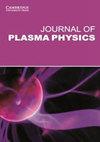利用激光驱动的 LIGHT 光束线进行离子停止力实验
IF 2.1
3区 物理与天体物理
Q2 PHYSICS, FLUIDS & PLASMAS
引用次数: 0
摘要
GSI Helmholtzzentrum für Schwerionenforschung GmbH 的激光离子生成、处理和传输(LIGHT)光束线的主要重点是激光生成离子束的相空间处理。近年来,LIGHT 合作项目已成功产生并聚焦了能量为 8 MeV、时间持续时间短于 1 ns (FWHM) 的强质子束。利用 LIGHT 的短离子束特性,一个有趣的应用领域是研究等离子体中的离子停止功率,这是惯性约束聚变中的一个关键过程,用于了解高密度等离子体中的能量沉积。当射弹速度接近热等离子体电子速度($v_{i}\approx v_{e,\text {th}}$)时,是最具挑战性的阶段,现有理论对此显示出很大差异。由于在这一机制下缺乏确凿的实验数据,我们计划对激光产生的等离子体进行实验,用 LIGHT 产生的离子进行探测,其时间分辨率要比以前更高。高时间分辨率非常重要,因为激光产生的等离子体的参数是在纳秒级的时间尺度上变化的。为了实现这一目标,我们最近的研究涉及动能较低的离子。2021 年,我们用两个螺线管传输激光加速的碳离子,并用 LIGHT 的射频腔进行时间聚焦。在能量为 0.6 MeV u $^{-1}$ 时,实现了 1.2 ns(FWHM)的束长。2022 年,能量为 0.6 MeV 的质子被传输并在时间上压缩到 0.8 ns 的束长。质子束被用来测量冷箔中的能量损失。离子束和质子束还将用于测量等离子体靶的能量损失。本文章由计算机程序翻译,如有差异,请以英文原文为准。
Towards ion stopping power experiments with the laser-driven LIGHT beamline
The main emphasis of the Laser Ion Generation, Handling and Transport (LIGHT) beamline at GSI Helmholtzzentrum für Schwerionenforschung GmbH are phase-space manipulations of laser-generated ion beams. In recent years, the LIGHT collaboration has successfully generated and focused intense proton bunches with an energy of 8 MeV and a temporal duration shorter than 1 ns (FWHM). An interesting area of application that exploits the short ion bunch properties of LIGHT is the study of ion-stopping power in plasmas, a key process in inertial confinement fusion for understanding energy deposition in dense plasmas. The most challenging regime is found when the projectile velocity closely approaches the thermal plasma electron velocity (
$v_{i}\approx v_{e,\text {th}}$
), for which existing theories show high discrepancies. Since conclusive experimental data are scarce in this regime, we plan to conduct experiments on laser-generated plasma probed with ions generated with LIGHT at a higher temporal resolution than previously achievable. The high temporal resolution is important because the parameters of laser-generated plasmas are changing on the nanosecond time scale. To meet this goal, our recent studies have dealt with ions of lower kinetic energies. In 2021, laser accelerated carbon ions were transported with two solenoids and focused temporally with LIGHT's radio frequency cavity. A bunch length of 1.2 ns (FWHM) at an energy of 0.6 MeV u
$^{-1}$
was achieved. In 2022, protons with an energy of 0.6 MeV were transported and temporally compressed to a bunch length of 0.8 ns. The proton beam was used to measure the energy loss in a cold foil. Both the ion and proton beams will also be employed for energy loss measurements in a plasma target.
求助全文
通过发布文献求助,成功后即可免费获取论文全文。
去求助
来源期刊

Journal of Plasma Physics
物理-物理:流体与等离子体
CiteScore
3.50
自引率
16.00%
发文量
106
审稿时长
6-12 weeks
期刊介绍:
JPP aspires to be the intellectual home of those who think of plasma physics as a fundamental discipline. The journal focuses on publishing research on laboratory plasmas (including magnetically confined and inertial fusion plasmas), space physics and plasma astrophysics that takes advantage of the rapid ongoing progress in instrumentation and computing to advance fundamental understanding of multiscale plasma physics. The Journal welcomes submissions of analytical, numerical, observational and experimental work: both original research and tutorial- or review-style papers, as well as proposals for its Lecture Notes series.
 求助内容:
求助内容: 应助结果提醒方式:
应助结果提醒方式:


